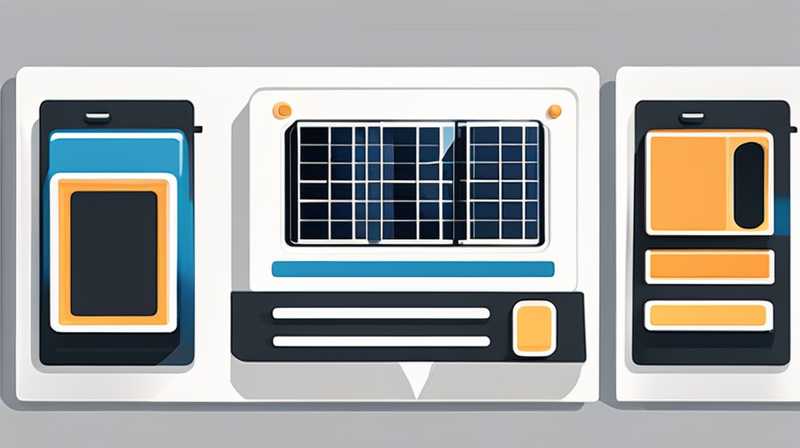
1. Understanding Solar Panel Line Compatibility with Equipment, 2. Identifying Suitable Components, 3. Ensuring Proper Installation, 4. Maximizing Efficiency and Performance.
Successfully aligning a solar panel line with the appropriate equipment involves several critical steps and considerations. 1. Assessing electrical specifications, 2. Selecting compatible inverter types, 3. Evaluating environmental factors, 4. Optimizing energy output are essential for achieving optimal functionality and efficiency. Each component must effectively communicate and operate within specified limits to guarantee seamless energy flow and enhance the overall performance of the solar power system.
1. UNDERSTANDING SOLAR PANEL LINE COMPATIBILITY WITH EQUIPMENT
The initial stage of aligning a solar panel line with equipment revolves around understanding the system requirements and the specifications of your solar array. Solar panels generate electricity through photovoltaic cells, converting sunlight directly into usable energy, which is processed through various system components, including inverters, batteries, and loads.
Diving deeper, it is crucial to match the voltage and current ratings of your solar panels to the inverter and battery system. The voltage of the solar panel array must be complementary to the inverter input voltage range for the inverter to function efficiently. Typically, solar panels have a voltage rating determined under standard test conditions, often requiring the installation to best accommodate variations due to environmental factors.
2. IDENTIFYING SUITABLE COMPONENTS
Upon analyzing the specifications, it becomes necessary to shift focus towards selecting equipment that aligns with the requirements strained by the solar panel line. Inverters serve as crucial components, converting DC electricity produced by the solar panels into AC current suitable for household and commercial use. It is vital to consider both the type of inverter and its capacity, which should harmoniously match the output of the solar panels.
Furthermore, battery storage systems also play a vital role in energy management. An adequate battery system will store excess energy produced during sunlight hours, providing a reliable energy source when the sun isn’t shining. The selection of a battery also needs to align with the system’s voltage levels while supporting the total watt-hour capacity that corresponds with the expected daily energy consumption.
3. ENSURING PROPER INSTALLATION
Achieving compatibility with the equipment does not solely hinge on selecting the right components but extends to the installation phase as well. Proper installation is critical for maximizing the efficiency and longevity of the solar power system. Ensuring that all wiring, connections, and mounting systems are aligned correctly is absolute.
Moreover, ensuring that the inverter and battery systems are devoid of obstructions and heat sources will bolster their functionality and lifespan. Installers must pay attention to guidelines specified by manufacturers concerning spacing, ventilation, and installation angle, as these factors extensively influence energy creation and efficiency.
4. MAXIMIZING EFFICIENCY AND PERFORMANCE
In the latter stages, one must focus on optimizing the performance of the complete system. Regular maintenance is imperative in enhancing the operational efficiency of solar power systems. Periodic cleaning of panels and inspection of wiring and fixtures ensures that all components are functioning correctly.
Additionally, utilizing monitoring systems can offer insights into the performance metrics of the solar power system, allowing individuals to promptly address issues or inefficiencies. Continuous tracking of energy output can help identify peak performance hours and subsequently facilitate energy savings.
FREQUENTLY ASKED QUESTIONS
WHAT ARE THE IMPORTANT SPECIFICATIONS TO CONSIDER WHEN MATCHING SOLAR PANELS TO EQUIPMENT?
When matching solar panels to equipment, several specifications must be meticulously reviewed. The crucial parameters include voltage, current ratings, wattage output, and efficiency ratings. Ensuring that the solar panel voltage aligns with the inverter’s input requirements is fundamental. The panels’ current rating must also suit the inverter, contributing to better energy flow and system integration.
Wattage output is directly connected to the performance of the entire setup, determining how much electricity can be generated and fed into the system. Evaluating the efficiency ratings will inform users about how well the solar panel converts sunlight into usable energy, suggesting compatibility with specific charge controllers and must be matched with battery capacity to ensure all components are optimized for peak performance.
HOW DOES ENVIRONMENTAL FACTORS AFFECT EQUIPMENT MATCHING FOR SOLAR PANELS?
Environmental aspects significantly impact the integration of solar panels with compatible equipment, as factors like shading, temperature fluctuations, and geographical location determine overall performance. Colder temperatures often enhance photovoltaic efficiency, while extreme heat can reduce performance levels, making it imperative to choose components that can endure varying environmental conditions.
Moreover, choosing materials that resist corrosion or wear from harsh weather will maintain efficiency levels over time, ensuring reliable energy production. Awareness of local climate, projected sunlight hours, and accessibility to maintenance resources are indispensable when considering the environmental impact on solar panel and equipment compatibility.
WHAT TYPE OF INVERTER SHOULD I USE WITH MY SOLAR PANELS?
The right inverter type depends chiefly on the design and anticipated usage of the solar panel system. Three primary inverter types exist: string inverters, microinverters, and power optimizers. String inverters are generally suitable for conventional setups where all panels have similar orientations and shading profiles, making them easier to install and manage.
On the other hand, microinverters can monitor energy production on an individual panel basis, enabling optimal performance, particularly in shaded or complex configurations. Power optimizers enhance the performance of string systems, ensuring each panel’s energy output reaches its potential. Ultimately, selecting the inverter type revolves around the specific requirements, complexity, and intended application of the solar panel configuration.
With careful consideration of the outlined components and their compatibility with your solar panel line, you can ensure effective energy generation while maximizing efficiency and performance. From initial assessments to proper installation and ongoing maintenance, each step becomes vital in achieving a seamless and powerful solar energy solution.
Original article by NenPower, If reposted, please credit the source: https://nenpower.com/blog/how-to-match-the-solar-panel-line-with-the-equipment/


